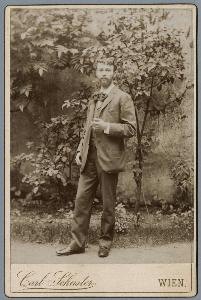Carl Schuster
Carl Schuster
Place: Milwaukee
Born: 1904
Death: 1969
Biography:
Carl Schuster was an American art historian who specialized in the study of traditional symbolism. He was born in Milwaukee, Wisconsin, to a prominent Jewish family. He received a B.A. (1927) and an M.A. (1930) from Harvard where he studied art history and oriental studies. He studied with Baron Alexander Staël von Holstein in Peking (1931–1933) and received his doctorate in 1934 in art history under the supervision of Julius von Schlosser. He worked briefly as Assistant Curator of Chinese Art at the Philadelphia Art Museum but was soon back in China (1935–38) pursuing his researches and traveling. He was assisted in his researches by academic grants from the Harvard-Yenching Institute, the Bollingen Foundation, and the Guggenheim Foundation. He collected and photographed specimens in his widespread travels, but he never wandered randomly. He lived an almost ascetic life. In rural areas, he could readily satisfy hunger with a heaping bowl of fresh rice, which cost one cent. He never raised his camera to record Mao's Long March, though he witnessed it. Detained by Japanese soldiers in rural China, he recorded the event merely to explain why certain notes and negatives were missing. He literally walked through famine, revolution, and war. Some of his rare Chinese embroideries were purchased by George Hewitt Myers for the Textile Museum and another large group was given to the Field Museum in Chicago. He also donated a group of Chinese prints to the New York Public Library as well as a collection of Buddhist woodcuts. After World War II, he lived in Woodstock, New York, where he began to develop his ideas, publishing learned monographs on traditional design motifs. He generally placed these studies in specialized publications, whose readers, he hoped, would respond with more leads. Harvard University was on the verge of publishing a book, The Sun Bird, but he withdrew it at the last moment because he felt it contained errors. The American Museum of Natural History (AMNH) provided him with a desk and he spent much time there and in the New York Public Library. In 1945, the American Anthropological Association sponsored an exhibition of his photographs at the AMNH illustrating his ideas about how certain symbols were shared by widely separated cultures. Along with the artist Miguel Covarrubias, the curator Rene d'Harnoncourt, and the politician and philanthropist Nelson Rockefeller, Schuster was involved in the foundation of the Museum for Primitive Art (now part of the Michael Rockefeller wing of the Metropolitan Museum of Art). He continued to travel, attending conferences and doing fieldwork and to correspond with others who shared his interests. Scattered around the world, often in remote or unlikely places, were hundreds of self-trained scholars, who in response to some personal passion, sought to preserve the last remnants of fading, local traditions. They were primary sources for Schuster's work.

